|
|
THE ANGRY RED PLANET:
A Space Fantasy with a pre-psychedelic look
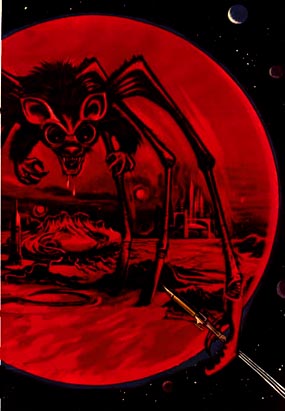 Celebrating the movie miracle of CINEMAGIC!
Celebrating the movie miracle of CINEMAGIC!
In 1960 Hollywood space fantasy was being phased out by America's real space program. Public
acceptance of the concept of space travel had been given a considerable boost by 1950's
Destination Moon, and the '50's had seen a number of fancifully
expressive and technically impressive space movies. But the latter end of the decade was
dominated by cutprice efforts like Missile to the Moon, of which
even genre fanatics had little good to say. How could yet another space saga sans budget
distinguish itself?
Independent producers Sidney Pink and Ib Melchoir found the answer in an effect they called
Cinemagic, in their film The Angry Red Planet. Garish crimson posters sporting a slathering
Martian monster called a 'Bat-Rat-Spider Crab' promised something totally new, a claim
impressionable 7-year-olds like myself took at face value. 'Show us', we said as we
marched into the matinee. This was the kind of audience that oohed and ahhed at the
flimsiest special effects, who shuddered in horror at the obvious theatrics of fare like
The Atomic Submarine. So innocent were we 1960 tots that I cannot say we had a firm
grip on the difference between movies and reality, a situation that made for some pretty wild
movie experiences.
The Angry Red Planet ambled along like so many other cheapies. Part of the matinee
experience was patience, i.e., sitting through boring movies to get to the 'good stuff', and
ANGRY had its share of scientists standing around talking. Even the special effects of
the flight to Mars were rather bogus, the spaceship looking just like an ordinary Atlas
rocket, not particularly well animated. We were a fastidious bunch of critics. When
the lunar liftoff in Missile to the Moon was depicted by superimposing a V-2 rocket,
gantry and all, over a desertscape, we rolled our eyes and yelled 'fake!'. But when toys
zigged and zagged on wires across painted skies, and buildings disintegrated like cardboard
boxes in Battle in Outer Space, we were enchanted. Missile was a gyp, while the
Japanese film delivered the goods.
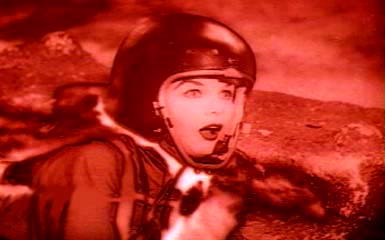 Nora Hayden, through rose-colored glasses?
Nora Hayden, through rose-colored glasses?
None of this prepared us for the spectacle of Cinemagic. Every sci-fi fan knows that the
make-or-break scene of a rocket movie is the moment when they say 'Open the door' and step out
onto a new planet. If it was Griffith Park, with feeble excuse dialogue like 'Look, Bart, trees
very much like those back on Earth!', the response would be very negative. Instead, we
saw something we indeed had never seen before. Mars in Cinemagic was blood-red, with white
and yellow highlights. The image looked very flat, and the still jungle landscape seemed
very dead and very alien. It wasn't just tinted red. Some parts of the image were
like a negative. Areas that should have been in shadow were instead a glowing, burnt-out
white. Relative shadings of dark and light were off balance, so normal clues to perspective
and texture were not always present. Trees were reduced to their dark outlines, faces
became masks without detail, and a lake looked like molten metal instead of water.
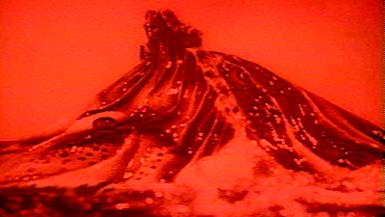 Amoeba? or jellyfish?
Amoeba? or jellyfish?
What Pink's special effects man Norman Maurer (and cinematographer Stanley Cortez?) had
created was similar to a still photography process called solarization, soon to become a familiar
sight in graphics but little-known in 1959. Not only did they produce a unique and
startling look, but they saved a tremendous amount of money in production costs. First,
as Cinemagic was a lab trick, all the Mars scenes were actually shot in inexpensive black & white.
And since scenery, props, etc. in Cinemagic were reduced to sketchy abstractions of
their real selves, a crummy rented rubber prop looked just as real as the living people in
the scene. Many of the wide shots were crude paintings, even cartoonish drawings, that
came off as fascinating in Cinemagic's red glow. The level of detail was so reduced that
it was possible to overlook the fact that the pressure-suited spacemen wore flight helmets
with no visors! The Martian city glimpsed faroff across the waveless crimson sea was
little more than a sketch (reminiscent of poster art for Beyond the Time Barrier). A blob
of rubber became the giant Amoeba, and the startling Rat-Bat-Spider Crab was just a hairy marionette.
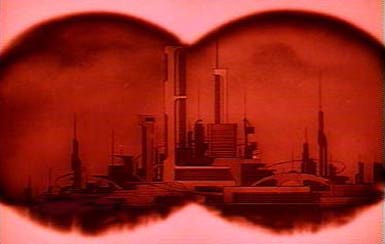 Mysterious city in Cinemagic binocular view.
Mysterious city in Cinemagic binocular view.
Daily Variety reviewed The Angry Red Planet at a November 25, 1959 screening when the
film had yet to find a distributor. It must have been a theater full of jaded industry
types expecting a serious drama (or prejudiced against independent product) because the review
gave the film low marks and singled out its Cinemagic process as no big deal. "While it
may take considerable ingenuity to produce this effect, the result isn't really worth it",
the Variety review reads, and calls the picture 'ordinary'. This must have been
a setback for the producers, who surely were expecting their creativity to result in a big
studio sale. Instead the movie landed at American International Pictures, the final
destination of many an unsellable exploitation film. Ib Melchoir eventually did another
space opera with Byron Haskin at Paramount called Robinson Crusoe on Mars that was
equally creative, yet not considered a great success either. Sidney Pink moved his
operation to Denmark and made Journey to the 7th Planet and Reptilicus, both
considered a big step downward, yet (like everything Sam Arkoff seems to have touched) solid
moneymakers for A.I.P.
We now have seen decades of solarization in everything from psychedelic rock posters to
cigarette ads, and especially those slick credit sequences in '60's spy movies where it
was cleverly used as an aesthetic ticket to slip nudity by the censors (see Our Man
Flint, whose titles are practically a sex education film). But the Cinemagic gimmick
of The Angry Red Planet startled us with its truly alien look.
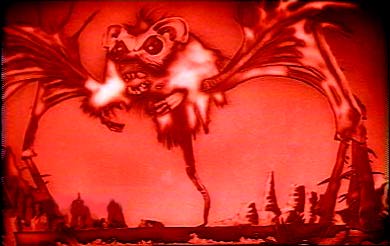 The outlandish Bat-Rat-Spider Crab
The outlandish Bat-Rat-Spider Crab
Reference: So You Want to Make Movies?, Sidney Pink, Pineapple Press,
Sarasota, Florida 1989. The Angry Red Planet can currently be seen on the AMC cable channel.
Reference: Ib Melchior, Man of Imagination, Robert Skotak, Midnight Marquee Press,
Baltimore, Maryland 2000.
You can read Savant's (much later) review of MGM's eventual DVD of
The Angry Red Planet.
Text © Copyright 1998 Glenn Erickson
DVD Savant Text © Copyright 2007 Glenn Erickson
|







 Celebrating the movie miracle of CINEMAGIC!
Celebrating the movie miracle of CINEMAGIC!



